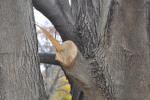|
Certain species of
trees develop wood that is brittle and will break
apart easily under stress from winds, snow or ice.
They are also generally "messy" trees which lose
twigs and small branches throughout the year.
 Another bad
characteristic is that they develop branch forks or
crotches that have a narrow angle. These types of
connections are inherently weak and are more liable
to break under stress than crotches that have a
wider angle between the branches. In fruit trees,
young trees are purposely trained to have wider
crotch angles so that they can handle the weight of
the fruit load. Another bad
characteristic is that they develop branch forks or
crotches that have a narrow angle. These types of
connections are inherently weak and are more liable
to break under stress than crotches that have a
wider angle between the branches. In fruit trees,
young trees are purposely trained to have wider
crotch angles so that they can handle the weight of
the fruit load.
Generally, the one
thing that all of these trees have in common is that
they are known to be "fast growing" plants. This
rapid growth rate translates into wood that is not
strong and durable. These types of trees should
usually be avoided for use in the home landscape.
|



